This site is supported by our readers. We may earn a commission, at no cost to you, if you purchase through links.
 The best diet for your pet snake depends on its species.
The best diet for your pet snake depends on its species.
The diet includes various food sources, such as small rodents and lizards for corn snakes, while ball pythons prefer rats, green tree pythons eat birds, and garter snakes go for fish and frogs.
But it’s not just about what they eat—it’s also about the nutrients they need, including calcium and phosphorus for bone health, and vitamin D3 helps with calcium absorption.
Proper UVB lighting aids this process and promotes strong, healthy bones.
Fresh water is a must, and don’t forget the importance of species-specific humidity levels.
Now, let’s slither into the specifics of snake nutrition and how to keep your scaly friend healthy and happy!
Table Of Contents
- Key Takeaways
- Snake Nutrition Basics
- Choosing Snake Food
- Environmental Factors
- Feeding Techniques and Schedules
- Recognizing Nutritional Deficiencies
- Maintaining Healthy Snake Nutrition
- Frequently Asked Questions (FAQs)
- What to feed a pet snake?
- Should a pet snake eat whole prey?
- What do snakes eat?
- What is the best diet for a snake?
- How do you feed a snake at PetSmart?
- Do snakes need a balanced diet?
- What is a snake’s favorite food?
- What food is toxic to snakes?
- What does a snake eat in 30 words?
- Can I feed my snake fruit or vegetables?
- Conclusion
Key Takeaways
- Your snake’s diet depends on its species. For example, corn snakes enjoy small rodents and lizards, while ball pythons prefer rats.
- Provide a balanced diet with essential nutrients like calcium, phosphorus, and vitamin D3 for bone health and overall wellness.
- UVB lighting acts like a multi-vitamin boost, aiding in vitamin D3 synthesis and promoting strong, healthy bones.
- Keep your snake well-hydrated with fresh water and maintain species-specific humidity levels to prevent dehydration and aid shedding.
Snake Nutrition Basics
Providing your pet snake with a nutritious diet is key to keeping them healthy and happy.
To guarantee your scaly friend thrives, it’s essential to understand their unique nutritional needs, from essential nutrients like calcium and vitamin D3 to the importance of whole prey and proper hydration.
Essential Nutrients for Snakes
So, your scaly friend’s a carnivore with very specific dietary needs.
Their health depends on these essential nutrients:
- Calcium and Phosphorus: Aim for a 2:1 ratio. This duo guarantees strong bones and healthy muscle function.
- Vitamin D3: This helps with calcium absorption, keeping their bones tip-top.
- Protein and Trace Minerals: Think zinc and magnesium. These support immunity and digestion, keeping their insides happy.
Now you know the basics of keeping your snake well-fed and healthy.
Dietary Needs by Species
Every snake has unique tastes, and it’s vital to know their favorite meals for a healthy, happy pet.
From corn snakes to king cobras, each species has specific dietary needs and preferences.
For example, ball pythons enjoy a rat-based diet, while constrictors constrict their meals without the need for venom.
Snakes require specific nutrients, and a helpful resource for understanding their dietary needs is this snake species diet guide.
Knowing these preferences is key to keeping your slithery friend well-fed and satisfied.
| Snake Species | Dietary Preference | Dietary Needs |
|---|---|---|
| Corn Snake | Small rodents, lizards, baby mice | Juveniles need smaller prey |
| Ball Python | Rats | Higher nutrient content |
| Green Tree Python | Birds, small mammals | Arboreal lifestyle |
| King Cobra | Other snakes | – |
| Garter Snake | Fish, frogs, earthworms | Buffet-style feeder |
Importance of UVB Lighting
UVB lighting is a snake owner’s secret weapon for keeping your pet healthy and strong.
It’s like a multi-vitamin boost, offering these key benefits:
- UVB Benefits: UVB rays are like a snake’s daily dose of sunshine, triggering vitamin D3 synthesis, which aids calcium absorption for strong, healthy bones.
- Lighting Systems: Invest in a good UVB lighting system, ensuring the right temperature, humidity, and lighting conditions for your snake’s habitat.
Vitamin D3 is essential for calcium absorption, and UVB lighting provides the perfect conditions for this process, promoting bone health and overall wellness.
Think of UVB lighting as your snake’s bone insurance, preventing issues like weak bones and providing the foundation for a long, healthy life.
Hydration and Humidity Requirements
Just like us, snakes need good hydration.
Provide fresh, clean water daily in a sturdy bowl.
Proper humidity levels, often species-specific, prevent dehydration and aid shedding.
For detailed guidance, explore these snake humidity requirements.
Monitor your snake for signs of dehydration like sunken eyes or wrinkled skin.
Controlling humidity and temperature through environmental factors guarantees your snake thrives.
Maintaining excellent water quality is key to a healthy, happy snake.
Choosing Snake Food
Choosing the right food for your pet snake is essential for its health and happiness.
You’ll learn about selecting prey that matches your snake’s size and nutritional needs, offering a varied diet, and steering clear of toxic foods to keep your slithery friend well-fed and content.
This will help you understand the importance of a balanced diet for your pet, focusing on key aspects such as nutritional needs.
Prey Size and Type Selection
Matching prey to your snake’s girth guarantees smooth swallowing and a happy, healthy snake.
You don’t want to serve a meal that’s a tight squeeze!
Here’s a snake feeding guide to choosing the right prey size and types for your pet:
- Prey Variety: Offer a range of prey items to meet nutritional needs and keep mealtimes interesting.
- Snake Preferences: Each snake has unique tastes.
- Feeding Trials: Experiment with different prey to find their faves.
- Prey Rotation: Mix things up to prevent boredom.
- Meal Planning: Balance their menu with a mix of prey types and sizes for a healthy carnivorous diet.
Understanding proper snake food options is vital for a well-rounded feeding strategy.
Now you’re equipped to offer a tasty and nutritious spread!
Variety in Prey Selection
Sure, variety’s the spice of life, and it’s no different for your slithery sidekick.
Keep things interesting by rotating their prey. This prey rotation prevents boredom and also guarantees your snake gets a well-rounded diet.
Each prey type offers unique nutrients, so switching things up meets their diverse dietary needs. Plus, it’s fun to watch them try new foods and express their snake preferences.
So, mix it up with rodents, birds, fish, and more, for a tasty adventure that provides a well-rounded diet. Your snake will thank you for this.
Avoiding Toxic Food Sources
Some tasty treats for us are toxic treats for snakes.
Steer clear of these common toxic foods to keep your slithery friend safe:
- Avocados
- Fireflies
- Citrus Fruits
- Dumb Cane
These foods can cause serious health issues, from tummy troubles to throat swelling.
So, stick to safe prey options and always keep an eye out for food poisoning signs.
When considering alternative food sources, research snake food options to guarantee a balanced diet for your pet snake.
Benefits of Gut-Loaded Prey
Gut-loading" is a smart way to boost your snake’s nutrition.
It’s like giving them a multivitamin with their meal.
Imagine a tiny, scaly bodybuilder flexing after a gut-loaded feast.
Gut-loaded prey, especially rodents, offer a triple threat: extra nutrients, prey variety, and happier snakes.
It’s a no-brainer for their diet plan.
When selecting the right food, understanding Gut Loaded Prey options is vital for superior snake nutrition.
| Benefits | Gut-Loaded Prey | Snake Nutrition |
|---|---|---|
| Nutrient Boost | X | Extra vitamins and minerals |
| Prey Variety | X | More than just mice |
| Healthy Digestion | X | Happy, healthy snakes |
Environmental Factors
Environmental factors play a huge role in your snake’s digestion and overall health.
It’s not just about the food they eat, but also the temperature, humidity, and lighting in their environment, as well as keeping stress levels low.
Temperature and Digestion Relationship
You might’ve heard that snakes like to sunbathe, but it’s not just for fun.
These reptiles rely on the right temperatures to digest their meals efficiently.
Here’s the lowdown on why temperature matters:
- Thermal Gradient: Snakes chill at different temps throughout their habitat.
- Digestion Rate: Higher temps mean faster digestion. A toasty belly helps break down food.
- Temperature Control: Snakes adjust their body heat during digestion, showing they know what’s up.
- Metabolic Speed: Warmer snakes burn calories quicker. No lazy lizards here!
Understanding digestive health tips is essential for providing the best care for your pet snake.
Humidity Impact on Hydration
The right humidity levels are key to keeping your snake hydrated and healthy.
Too dry, and they’ll struggle to shed and digest; too humid, and you invite bacteria and respiratory issues.
Aim for species-specific humidity sweet spots.
| Snake Type | Ideal Humidity Range |
|---|---|
| Corn Snake | 40-50% |
| Ball Python | 55-65% |
| Green Tree Python | 60-80% |
| Leopard Gecko | 30-40% |
| Bearded Dragon | 20-40% |
Lighting and Vitamin D3 Synthesis
The right lighting is key to keeping your snake healthy and happy.
UVB lighting is like a snake’s sunshine—it triggers vitamin D3 synthesis, which helps with calcium absorption and bone health.
This is why UVB lighting is so important for your slithery friend.
You can also give vitamin D3 supplements if natural lighting isn’t an option.
Lighting, temperature, and hydration all work together to keep your snake’s digestion and nutrient absorption on point.
Stress Factors Influencing Appetite
Environmental stress factors can impact a snake’s appetite, so it’s important to keep their anxiety at bay.
Handling techniques play a huge role in keeping your snake chill.
Here are some stress factors to keep in mind:
- Snake Anxiety: Keep handling sessions brief and calm, especially before meals.
- Feeding Routines: Stick to a consistent feeding schedule and prey type to avoid stressing your snake.
- Appetite Triggers: Loud noises, improper handling, and sudden movements can trigger snake anxiety and even regurgitation.
Keep things calm and consistent, as snake anxiety can lead to health issues and a refusal to eat, and environmental changes can disrupt their appetite.
Feeding Techniques and Schedules
Feeding your pet snake doesn’t have to be a challenging task.
You’ll learn the ins and outs of feeding techniques and schedules, including how often to feed your snake based on its age and species.
Some handy tips will be provided for making the process safe and stress-free for both you and your scaly friend, utilizing effective feeding schedules.
Feeding Frequency by Age and Species
How often should I feed my snake?" is a common question among owners.
It depends on their age and species.
Young snakes, especially hatchlings, have a faster metabolism and need to eat more frequently—about every 4 to 7 days.
Adult snakes can go longer between meals, typically once or twice a week.
This varies with the type of snake, so tailor your snake diet plan accordingly.
Keep an eye on prey size, too, as it should match your snake’s girth.
Using Food Tongs and Handling Prey
Now that you know how often to feed your slithery friend, let’s talk about the tools of the trade.
Using food tongs is a must when handling prey items.
It’s not just about keeping your hands clean (although that’s a plus).
Tongs give you control over presenting the prey to your snake, ensuring a smooth feeding process.
This is especially important if your snake is still getting used to mealtime routines.
Always handle frozen-thawed prey with care to avoid any accidental nicks.
For ideal feeding results, investing in quality food handling tools can make a significant difference in the overall health of your pet snake.
Monitoring Snake Health and Behavior
After presenting your snake its meal, the job isn’t over.
Keep a close eye on your snake’s behavior and overall health.
Regular health checks, including weight management and appetite monitoring, are key.
Look out for potential feeding issues.
Is your snake consistently refusing food?
Is it losing weight?
These can be red flags.
- Notice sudden weight loss? Could be a health issue.
- Refusing meals? Time to check for illness or stress.
- Healthy snake = happy snake.
Stay observant!
Adjusting Diets for Senior Snakes
As your pet enters its golden years, senior snake care becomes a priority.
Aging nutrition needs differ from their youthful days, and you’ll need to make some dietary adjustments to cater to their changing snake life stages.
Here are some elderly feeding tips for superior senior snake nutrition:
- Smaller Prey: Opt for smaller prey items as their appetite and digestion change.
- Less Frequent Meals: Senior snakes may only need to dine every two to four weeks.
- Monitor Weight: Keep an eye on their weight to confirm they’re not losing too much.
- Vet Advice: Consult a vet for guidance on senior snake health issues and customized snake diet planning.
Recognizing Nutritional Deficiencies
Keeping your pet snake healthy means knowing the signs of nutritional deficiencies.
We’ll help you spot the common issues, like weak bones and poor shedding, so you can take the right steps to get your scaly friend back on track, which involves understanding common issues.
Common Deficiencies in Snakes
Nutritional deficiencies in snakes can lead to some serious health issues.
You don’t want a scaly friend with fragile skin or impaired immune function.
Keep an eye out for signs of vitamin deficiency, like fragile skin, dry mouth, and respiratory issues.
Mineral imbalances, feeding errors, nutrient absorption issues, and metabolic problems can also cause snake health issues.
A calcium-phosphorus imbalance, for example, can lead to weak bones.
Recognizing snake nutritional deficiencies is essential for maintaining the overall health and well-being of pet snakes, especially in preventing serious health issues and ensuring immune function.
Signs of Malnutrition and Obesity
So, your scaly friend is looking a little… well, off.
Malnutrition symptoms in snakes are pretty clear: weak bones, poor shedding, and a generally sad demeanor.
Obesity risks are no joke either—an overweight snake is a sign of overfeeding and can lead to serious health issues.
Keep an eye out for weight issues, as sudden loss or gain could signal feeding disorders or nutrient deficiencies.
Corrective Measures and Veterinary Intervention
So, your snake’s looking a little scrawny.
First, don’t panic, malnutrition’s no joke, but there’s a fix.
You might need to tweak their diet or feeding schedule.
Try leaner meals, like a well-sized rodent.
For insect eaters, load their bugs with nutrients.
And double-check that calcium-phosphorus ratio.
If things are dire, your vet will examine your snake and may suggest health supplements or tests.
Importance of Record Keeping and Weight Monitoring
Keeping tabs on your snake’s weight is like watching the scales for a weightlifter—it’s a surefire way to gauge health and progress.
Regular weight checks and body condition scoring are necessary for spotting nutritional deficiencies.
Here’s why recordkeeping is essential:
- Feeding Logs: Track meals and portions to guarantee a balanced diet and prevent overfeeding.
- Health Monitoring: Record weight changes to detect issues early.
- Growth Charts: Plotting weight over time reveals proper development and nutritional needs.
A sudden drop in weight could signal illness, making regular monitoring crucial for the snake’s well-being.
Maintaining Healthy Snake Nutrition
Maintaining healthy snake nutrition is key to your pet’s well-being. This section will cover safe feeding practices, keeping your snake well-hydrated, and tailoring their diet as they age.
Safe Feeding Practices and Precautions
Here are some snake safety tips for you: Keep your snake’s dining area stress-free and separate from their living space.
Use food tongs to offer thawed prey—no live rodents! Sanitize feeding tools and surfaces. Handle frozen-thawed prey with care to avoid contamination.
Store food safely, keeping toxic foods like garlic far away. Always supervise your snake during meals for their safety and yours.
These simple steps guarantee safe feeding and a healthy, happy snake companion.
Snake Water Requirements and Hydration
Water is life, and that’s especially true for your slithery sidekick.
Keeping their H2O fresh and clean is key to a healthy, happy snake.
Here’s the lowdown on snake hydration:
- Water Quality Matters: Provide fresh, clean water at all times.
- Water Quality Matters is crucial, and to achieve this, change the water daily and use a large, heavy, spill-proof bowl to prevent messes and keep your snake’s environment dry.
- Humidity Levels: Aim for species-specific humidity levels to support hydration.
- Too dry and they’ll struggle to absorb water; too humid and you risk respiratory issues.
- Bowl Sanitation: Disinfect the water bowl daily to prevent bacteria buildup.
A clean bowl equals healthy hydration.
Understanding snake hydration tips is vital for maintaining prime health and preventing dehydration in pet snakes.
To learn more about snake care, including information on dietary considerations, I recommend consulting a veterinarian or a reputable herpetology resource.
Dietary Considerations for Species and Age
As snakes slither through their growth stages, their dietary needs evolve.
Their dietary needs vary across species and age, a factor that is crucial in determining the right food for them. A hatchling’s diet differs from that of a senior snake—think tiny rodents for the little ones and smaller prey, less often, for older snakes.
Some species, like pythons, have unique dietary shifts, so tailor your snake diet guide to their species-specific needs. Keep age-specific diets in mind, adjusting portions and frequency as they grow.
Frequently Asked Questions (FAQs)
What to feed a pet snake?
What’s for dinner?" It’s a fair question, and one snake owners often ask.
A healthy snake diet includes whole prey like mice or rats, matched to your snake’s width for easy swallowing.
Add vitamins and minerals, and you’re serving up a slithering feast!
Should a pet snake eat whole prey?
Yes, your pet snake should eat whole prey. This is because snakes are carnivorous and have a unique digestive system that’s adapted to consuming prey whole.
What do snakes eat?
Snakes are carnivores with a taste for whole prey, from rodents to birds and fish.
They gobble up their meals, bones and all, with a side of eggs or insects for variety.
Size matters—match prey to their girth for smooth swallowing.
What is the best diet for a snake?
You want your slithery friend to thrive, not just survive, right?
Well, the key to a healthy, happy snake is a balanced diet, just like us humans.
So, what’s the magic formula?
How do you feed a snake at PetSmart?
Here’s the lowdown on feeding your slithery friends at PetSmart.
You’ll want to match prey size to your snake’s width for easy swallowing.
Go for frozen-thawed rodents, presented from the side.
Simple, right?
Do snakes need a balanced diet?
Just like us, snakes thrive on a balanced diet. Their meals need to cover all the bases: protein, vitamins, minerals, and hydration. Get this wrong, and health issues slither in.
What is a snake’s favorite food?
It’s a tie between rodents and birds—snakes love the taste of a juicy mouse or a chick.
In the wild, they’ll also go for fish, eggs, and insects.
It’s like us and pizza—a natural combo.
What food is toxic to snakes?
Some foods are toxic to snakes, including avocados and garlic. Keep these foods away from your slithery friend to keep them healthy and happy.
What does a snake eat in 30 words?
So, what’s on the menu for your scaly friend?
A healthy snake diet includes whole prey like rodents, birds, fish, and insects.
It’s like a natural buffet, but without the salad bar.
Can I feed my snake fruit or vegetables?
No, you shouldn’t feed your snake fruits or veggies. Snakes are carnivores, meaning they’ve evolved to thrive on a diet of whole prey like mice or rats.
Conclusion
Finding the best diet for your pet snake is a tricky business.
You’ve got to be a nutritionist, a zookeeper, and a chef all in one.
But with this expert guide, you’re well on your way to becoming a snake-whispering, diet-savvy pro.
You now know how to keep your scaly friend happy, healthy, and full of wiggly energy.
So, go forth and feed with confidence, knowing you’re giving your snake the very best.
- https://talis-us.com/blogs/news/the-ultimate-snake-diet-guide-what-to-feed-your-pet-snake
- https://www.zenhabitats.com/blogs/reptile-care-sheets-resources/how-to-add-variety-to-your-snakes-diet-zen-habitats
- https://be.chewy.com/what-do-snakes-eat/
- https://www.petmd.com/reptile/nutrition/what-do-pet-snakes-eat
- https://vetmed.illinois.edu/pet-health-columns/pet-snakes-diet-dead-alive/


















